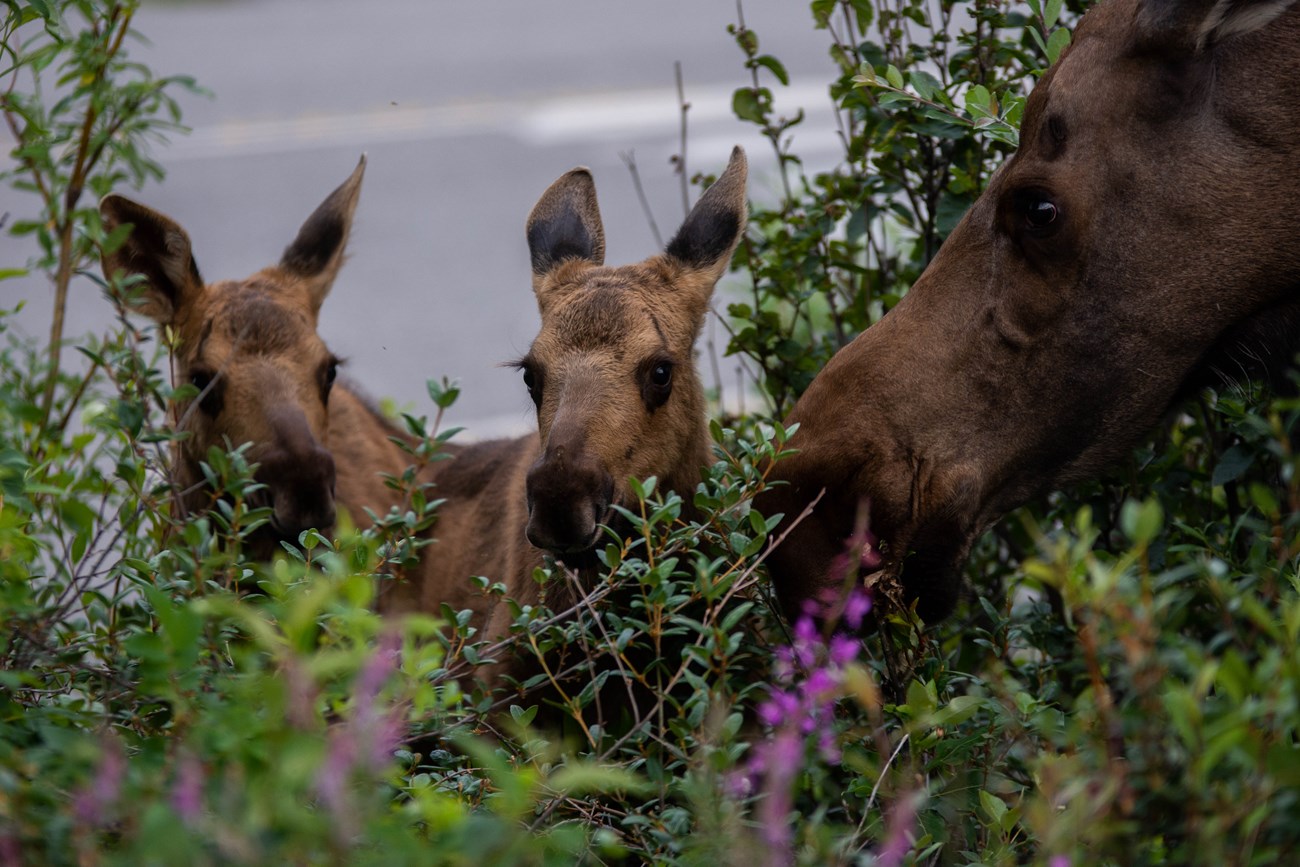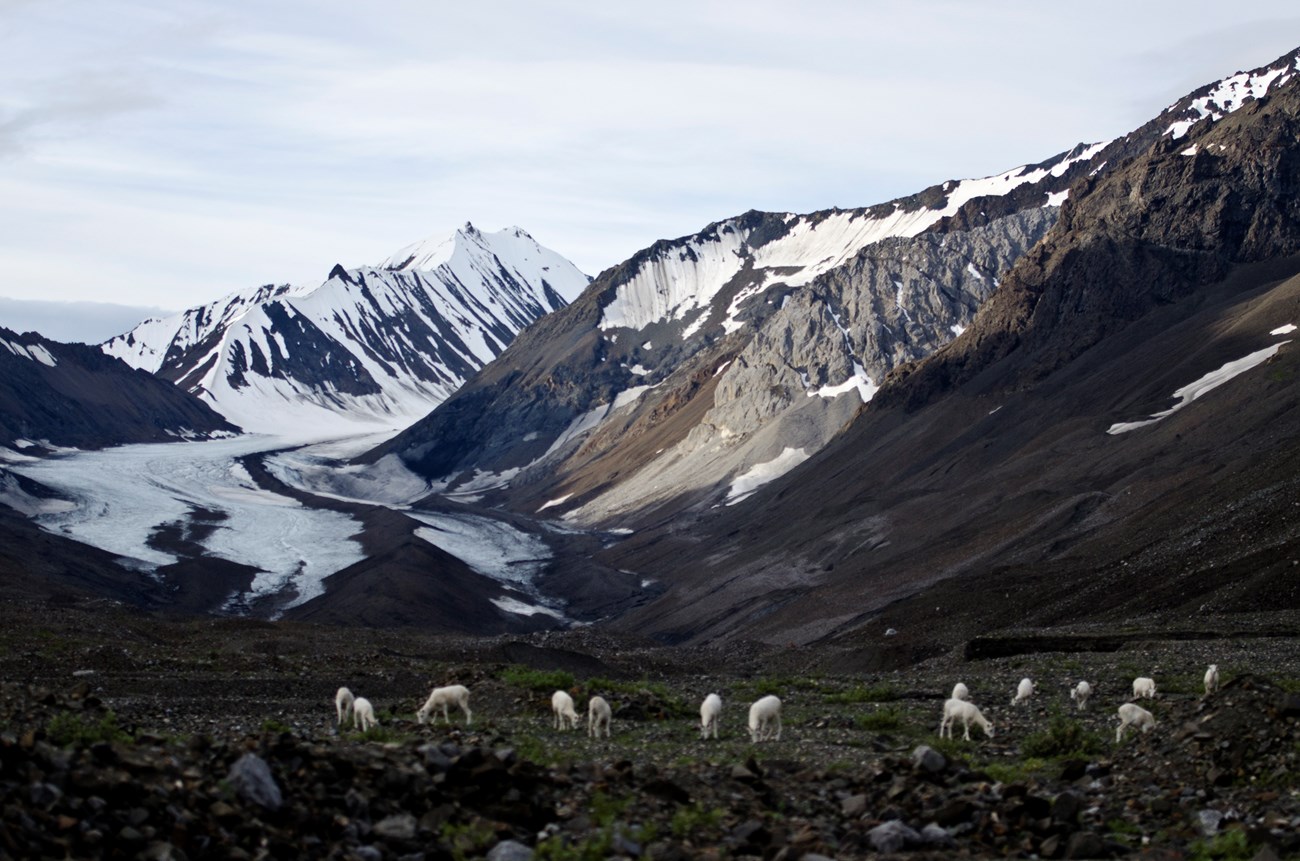Last updated: April 27, 2023
Article
Large Mammals in Denali: How Many Are There?
Last Updated: April 2023
Moose are increasing and are now quite common in Mount McKinley National Park
—Joseph Dixon, "Birds & Mammals of Mount McKinley National Park" (1938)

NPS Photo / Mary Lewandowski
With the exception of the road corridor and the area around park facilities, Denali National Park and Preserve is more than 9,000 square miles of wild terrain. That’s enough space for large animals to roam, rest, migrate, spar, sleep, avoid predators, browse, and do all the other things that large animals do in wild, unencumbered landscapes.
Innovative sampling techniques are used to estimate animal numbers, but the results are estimates of population sizes. Therefore it’s unrealistic to know exactly how many large mammals there are in Denali National Park and Preserve at any given time. Knowing about population trends, as well as about the quality and distribution of habitat for cover and food, is as important as knowing population sizes.
How To Estimate Populations
Aerial surveys are the primary means to estimate the size of large mammal populations. Imagine you’re the trained observer counting wildlife while the pilot flies the small fixed-wing plane over standard survey routes. You might track signals from radio-collared animals to locate non-collared ones in the same group. Knowing the number of animals per square mile from your survey, and how much of the park’s suitable habitat you covered, you can estimate the population size for the entire park.
Population sizes often are estimated separately on the north and south sides of the Alaska Range’s inhospitable spine of rock and ice. The timing of surveys makes a big difference in population estimates. Wildlife biologists working in the park provide these estimates of population sizes for Denali’s large mammals.

NPS Photo / Katie Thoresen
Grizzly Bears
On the north side of the Alaska Range, there are approximately 300–350 grizzly bears. This number is based on densities determined using radiocollaring of bears south and west of Wonder Lake (about 70 bears per 1,000 mi2 or 27 bears per 1,000 km2), then extrapolating to all grizzly bear habitat. On the south side of the Alaska Range, brown bear density is about 72 bears per 1,000 mi2 (28 bears per 1,000 km2). The density of grizzlies is likely to be higher south of the Alaska Range because the habitat includes more salmon streams. These estimates are the results of survey work done in the mid 1990’s and are the most current available.
Black Bears
Black bears have been observed throughout the park, particularly in forested areas. No formal surveys have been conducted north of the Alaska Range. The Alaska Department of Fish and Game (ADF&G) estimates that there are about 2700 black bears in Game Management Unit 16, or about 334 bears per 1,000 mi2 (131 bears per 1,000 km2). Based on the proportion of GMU 16B that is in Denali, there are about 200 black bears in the park on the south side. These estimates are the results of survey work done in the early 2000’s and are the most current available.
Wolves
In spring 2022, there were approximately 105 wolves in the 14 packs regularly being monitored by park biologists and 15 packs monitored by the fall. Den activity and pup productivity were monitored through radio tracking flights as well as data received remotely from Iridium radio collars all season. It appeared the 14 out of 15 packs monitored by fall denned and 13 packs had pups that survived to the fall.
Caribou
The fall 2022 parkwide preliminary estimate for the Denali Caribou Herd was about 1,510 caribou, a decrease from the 2021 estimate of 2,060. Ten percent of calves born in 2013 survived to September. This population estimate reflects a recent decline of the Denali Herd since 2018.
Moose
Moose surveys were last conducted within the park on the south side of the Alaska Range where subsistence users harvest moose (Cantwell area) in December 2018. Near Cantwell, 509 moose were observed in a 419 mi2 (1,085-km2) area. Moose numbers in this area appear to be stable or increasing slightly. The last survey on the north side of the Alaska Range was in 2017 and estimated 1,743 moose. This estimate is similar to the 2015 survey estimate but a slight increase over estimates done in the early 2000’s. Aerial moose surveys in the park are on hold for the time being (2023) while survey methodology is re-evaluated.
Dall Sheep
Estimates of the sheep population north of the Alaska Range in Denali National Park have ranged from about 1,100 – 2,000 from 2011 to 2020. New aerial survey techniques are being tested and updated population estimates are forthcoming (as of 2023).
Other Challenges
Even estimates of population size are difficult to obtain. The challenges of estimating numbers of large mammals in the park include:
- Births and deaths cause fluctuations in numbers.
- Numbers may change as animals travel in and out of the park--what’s a park boundary to an animal?
- Estimates made in one part of the park are extrapolated to other parts, assuming habitats are similar. There are limits to the accuracy of these assumptions.
- Some population estimates are based on multi-year counts (each year in a different location), so estimates are ready only when counts are completed.
- Sampling may be suspended when there is a lack of snow cover (to serve as a backdrop for seeing animals) or when aircraft are grounded by weather.
